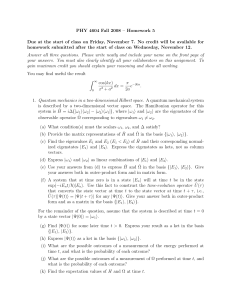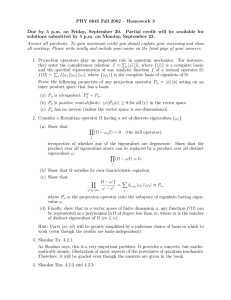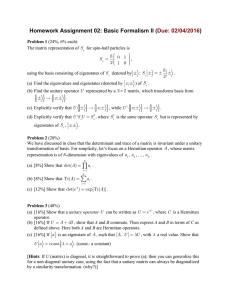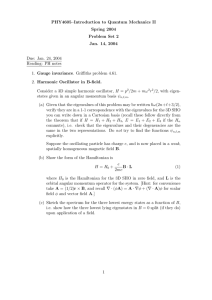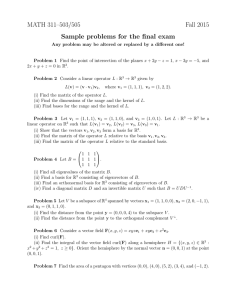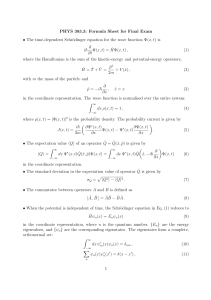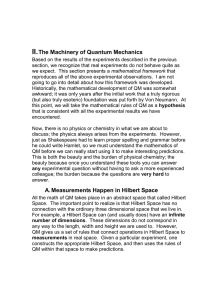PHY 4604 Fall 2010 – Homework 5
advertisement
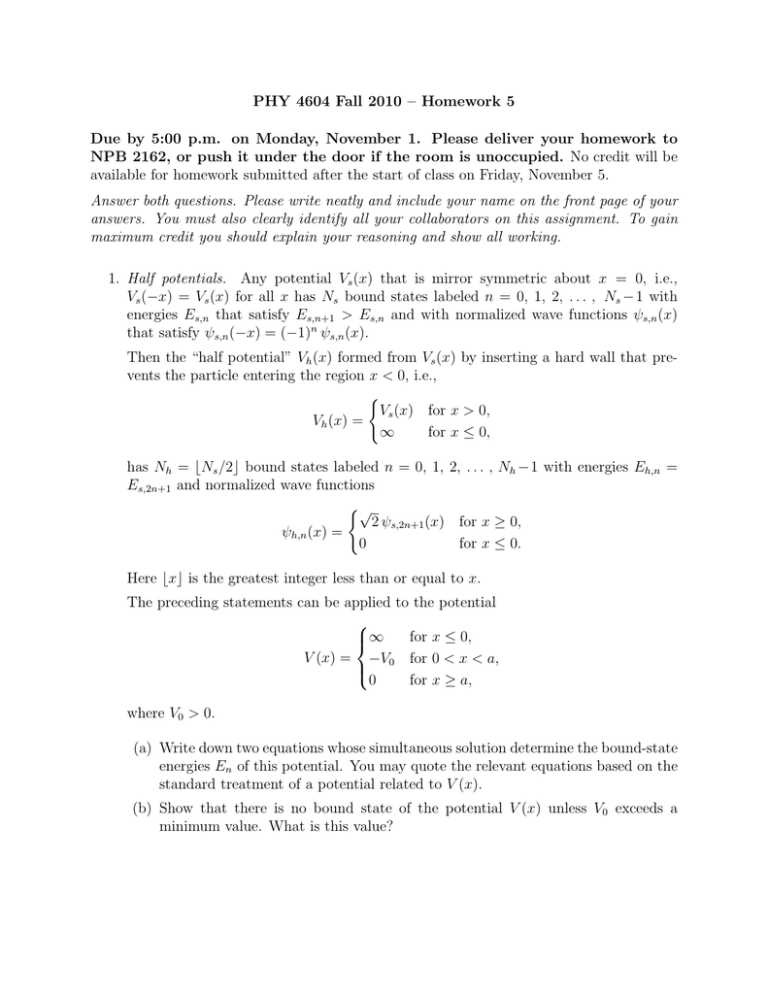
PHY 4604 Fall 2010 – Homework 5
Due by 5:00 p.m. on Monday, November 1. Please deliver your homework to
NPB 2162, or push it under the door if the room is unoccupied. No credit will be
available for homework submitted after the start of class on Friday, November 5.
Answer both questions. Please write neatly and include your name on the front page of your
answers. You must also clearly identify all your collaborators on this assignment. To gain
maximum credit you should explain your reasoning and show all working.
1. Half potentials. Any potential Vs (x) that is mirror symmetric about x = 0, i.e.,
Vs (−x) = Vs (x) for all x has Ns bound states labeled n = 0, 1, 2, . . . , Ns −1 with
energies Es,n that satisfy Es,n+1 > Es,n and with normalized wave functions ψs,n (x)
that satisfy ψs,n (−x) = (−1)n ψs,n (x).
Then the “half potential” Vh (x) formed from Vs (x) by inserting a hard wall that prevents the particle entering the region x < 0, i.e.,
(
Vs (x) for x > 0,
Vh (x) =
∞
for x ≤ 0,
has Nh = bNs /2c bound states labeled n = 0, 1, 2, . . . , Nh −1 with energies Eh,n =
Es,2n+1 and normalized wave functions
(√
2 ψs,2n+1 (x) for x ≥ 0,
ψh,n (x) =
0
for x ≤ 0.
Here bxc is the greatest integer less than or equal to x.
The preceding statements can be applied to the potential
for x ≤ 0,
∞
V (x) = −V0 for 0 < x < a,
0
for x ≥ a,
where V0 > 0.
(a) Write down two equations whose simultaneous solution determine the bound-state
energies En of this potential. You may quote the relevant equations based on the
standard treatment of a potential related to V (x).
(b) Show that there is no bound state of the potential V (x) unless V0 exceeds a
minimum value. What is this value?
2. Quantum mechanics in a two-dimensional Hilbert space. A quantum mechanical system
is described by a two-dimensional vector
space. The Hamiltonian operator for this
system is Ĥ = i∆ |ω1 ihω2 | − |ω2 ihω1 | , where |ω1 i and |ω2 i are the eigenstates of the
observable operator Ω̂ corresponding to eigenvalues ω1 6= ω2 .
(a) What condition(s) must the scalars ω1 , ω2 , and ∆ satisfy?
(b) Provide the matrix representations of Ĥ and Ω̂ in the basis {|ω1 i, |ω2 i}.
(c) Find the eigenvalues E1 and E2 (E1 < E2 ) of Ĥ and their corresponding normalized eigenstates |E1 i and |E2 i. Express the eigenstates as kets, not as column
vectors.
(d) Express |ω1 i and |ω2 i as linear combinations of |E1 i and |E2 i.
(e) Use your answers from (d) to express Ĥ and Ω̂ in the basis {|E1 i, |E2 i}. Give
your answers both in outer-product form and in matrix form.
(f) A system that at time zero is in a state |En i will at time t be in the state
exp(−iEn t/~)|En i. Use this fact to construct the time-evolution operator Û (τ )
that converts the state vector at time t to the state vector at time t + τ , i.e.,
Û (τ )|Ψ(t)i = |Ψ(t + τ )i for any |Ψ(t)i. Give your answer both in outer-product
form and as a matrix in the basis {|E1 i, |E2 i}.
For the remainder of the question, assume that the system is described at time t = 0
by a state vector |Ψ(0)i = |ω1 i.
(g) Find |Ψ(t)i for some later time t > 0. Express your result as a ket in the basis
{|E1 i, |E2 i}.
(h) Express |Ψ(t)i as a ket in the basis {|ω1 i, |ω2 i}.
(i) What are the possible outcomes of a measurement of the energy performed at
time t, and what is the probability of each outcome?
(j) What are the possible outcomes of a measurement of Ω performed at time t, and
what is the probability of each outcome?
(k) Find the expectation values of H and Ω at time t.
This question exemplifies the process changing the basis used to describe vectors in a
Hilbert space. Sections A.4 and A.5 of Griffiths provide a more general discussion of
basis changes using unitary (inner-product-conserving) transformations.
It should be clear from the spectral representation that any Hermitian operator corresponds to a diagonal matrix Ωmn = ωm δm,n when represented in the basis of its own
eigenstates. For this reason, the process of finding the eigenvalues and eigenfunctions
of an operator (or matrix) is often referred to as diagonalizing the operator (or matrix).
